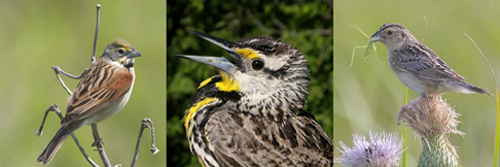|
|
 |
A dickcissel, eastern meadowlark and grasshopper sparrow (Photos courtesy of David A. Rintoul, K-State Division of Biology) |
Source: Kimberly With, 785-532-5040, kwith@k-state.edu
Photos available. Contact media@k-state.edu or 785-532-6415.
News release prepared by: Erinn Barcomb-Peterson, 785-532-6415, ebarcomb@k-state.edu
Tuesday, March 3, 2009
GRASSLAND BIRDS IN FLINT HILLS REGION OF KANSAS, OKLAHOMA FACE POPULATION DECLINE IN SPITE OF LARGE HABITAT AREA, ACCORDING TO FINDINGS BY K-STATE ECOLOGIST
MANHATTAN -- The wide-open spaces of the Flint Hills may no longer provide a secure home on the range for several familiar grassland birds, according to research by a Kansas State University ecologist and her colleagues.
The researchers found that three bird species common to the Flint Hills region of Kansas and Oklahoma are experiencing serious population decline in the face of extensive land-management practices like annual burning and widespread grazing
The Flint Hills contain the largest remaining tracts of tallgrass prairie, a habitat that once covered much of the Great Plains but of which only 4 percent is now left, mostly in the Flint Hills. Far from being pristine prairie, however, the Flint Hills region supports a major cattle industry and is intensively managed.
"Because of its size, the Flint Hills is assumed to be a population stronghold for grassland birds," said Kimberly With, a K-State associate professor of biology who led the study. "Mostly this has been based on bird counts, but they can be misleading because they don't show what the region is capable of producing. Birds are very mobile and thus birds could come from elsewhere to give the appearance of a stable population year after year. This is especially true if the region attracts birds because of its size, but birds do not breed successfully once they settle here."
With was joined by ecologists Anthony King from the Oak Ridge National Laboratory and William Jensen, a former postdoctoral researcher in With's lab at K-State. They conducted a two-year study of regional viability of three grassland birds: the dickcissel, grasshopper sparrow and eastern meadowlark. With and her colleagues found that none of these bird species is viable in the 4 million-acre Flint Hills region. They estimated population declines of as much as 29 percent per year during the years studied.
The results were published in December 2008 in the journal Biological Conservation, http://tinyurl.com/cza3xy
"Although considered to be relatively common, all three of these species have been exhibiting declines at a continent-wide level," With said.
According to a 2007 report by The National Audubon Society, two of these species -- the grasshopper sparrow and eastern meadowlark -- have lost 62 percent and 75 percent, respectively, of their global population in the past 40 years.
With and her colleagues found that birds are not breeding successfully in the Flint Hills. With said that more than 80 percent of nests were destroyed by predators. They also found that birds nesting in native prairie hayfields were more successful than birds nesting in grazed grassland. She said this might be because in the Flint Hills, the hayfields were mown later than in other prairie regions, enabling birds to finish nesting before the nests are mowed under.
"These hayfields are a less disturbed habitat than other managed grasslands in the Flint Hills, 90 percent of which is grazed and up to two-thirds may be burned," With said.
The researchers suggest that land-management practices may offer only part of the explanation for declining bird populations.
"There was a drought one of the two years we studied the birds, and in that year birds didn't do well anywhere," With said. "Under global climate change, we may see more prolonged droughts and less frequent, but more intense storms. If rain comes as intense storms with hail, that could be just as lethal to the birds."
With said that more study is needed before recommendations can be made to help manage these bird populations. But she said that the results are still valuable because -- like a canary in a coal mine -- birds indicate a region's overall environmental health.
"The cattle industry is important economically to the region," With said. "The region is also ecologically important. The challenge is to what extent you can successfully achieve these joint aims of agriculture and conservation within the Flint Hills."
The research was funded by the U.S. Department of Agriculture through the Cooperative State Research, Education and Extension Service's National Research Initiative Managed Ecosystems Program.